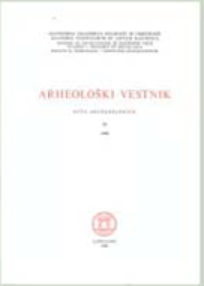The Orientation of Graves in Some Mediaeval Necropoles of Slovenia
Abstract
In this paper the question is treated whether the orientation of the mediaeval graves of Slovenia, which an the main is WE, was determined according to the real sunrise; if so, we could explain the greater or lesser deviations from the main direction (WE) aind, in connection with it, we may get a foothold for some palaeodemo[1]graphic particulars. For the investigation of the material (566 graves) from five Slo[1]vene necropoles three methods were worked out by means whereof the azimuths of each 15th of each month in the frame of the nort[1]hernmost and southernmost azimuths seen from necropoles at Bled and Ptuj, considering all eventual obstacles (hills, mountains, etc., cf. the Nomogram!). All necropoles, i. e. »Bled 1949«, »Bled 1948«, Ptuj, Turnišče, and Ljubljana were estimated as to these methods, whereat the sex and age of the skeletons were considered. Applying the first method we divided the material into 10 degree classes of deviations (cf. Tab. I and II). While applying the second method we divided the material into three groups only (Tab. Ill and IY), the first of which containing the »summer« graves within 19°—30° N of deviations; the second those within 18° N to. 24° S of deviations (i. e. graves corresponding to spring and autumn), and the third group of »winter« graves within the deviations of 25° to 37° S. Applying the third method we divided the material as to the deviations into groups of months (Tab. V and VI); finally, by method Ilia we found out how the graves are distributed in the respective months. So we were able to compare the mortality curve of this necropolis (»Bled 1949«) with the one for the town of Bled in the years 1948 by 1950 (Tab. VII, Diagr. 1). After all these preparations we may say that in Vllth century the inhabitants of Bled (»Bled 1949«) orientated their graves towards the actual sunrise of the day (or approximately so, at least); whereas it cannot be said with certainty for the necropoles »Bled 1948« (Tab. VIII—X), Ljubljana, and Turnišče (Tab. XIII). As to the necropolis of Ptuj (Xth to Xlth centuries) it seems (cf. Tab. XI and XII) that very probably the orientation of the graves was not decided indivi[1]dually and towards the actual daily sunrise, but only in the main direction (WE) with deviations which are not in connection with the yearly movement of the Sun. Thus for the necropolis »Bled 1949« the curve of mortality ac[1]cording to the months may be reconstructed with a greater pro[1]bability. This curve agrees mainly with the curve of mortality at present Bled, especially in winter (December, January, February) and spring (March, April, May), whereas it does not agree so well with the summer and autumn quarter of the year (cf. Tab. VII).Beside®, it appeared that the annual mortality curve of the present time is more balanced than it was in the early Middle Ages. This may be, partially at least, explained if we consider that the popu[1]lation of the early Middle Ages (in Central Europe at least) was more dependent on natural environment and occuirance® on one hand, and that we now live in much better hygienic and medical condi[1]tions, on the other hand. Thus e. g. pneumonia is no more a matter of life and death as it almost certainly was in the Middle Ages. The necropolis »Bled 1949« being historically the oldest one considered by us, we may imagine that in the past the ancient settler® of Bled buried their defunct according to the actual sunrise as they could observe it on the horizon. This custom seems to have been given up in the new socio-cultural conditions, particularly in collec[1]tion with the Christianization. Yet the main direction WE seems to have been held some time further. Maybe they buried (just in con[1]nection with the sometimes forcible Christianization) in haste, at night, secretly, as J. K o r o š e c supposes considering Ptuj, and that, according to the old tradition, they were 'keeping the main direction WE only, with greater or lesser deviations, having neither time nor opportunity to observe the sunrise
Downloads
Downloads
Published
How to Cite
Issue
Section
License

This work is licensed under a Creative Commons Attribution-NonCommercial-ShareAlike 4.0 International License.
Authors guarantee that the work is their own original creation and does not infringe any statutory or common-law copyright or any proprietary right of any third party. In case of claims by third parties, authors commit their self to defend the interests of the publisher, and shall cover any potential costs.
More in: Submission chapter





